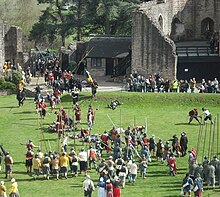Renaissance reenactment: Difference between revisions
Appearance
Content deleted Content added
revert spelling per WP:RETAIN; add citation verifying Renaissance fairs as a primarily American phenomenon. Article mentions English CW, Polish-Lithuanian, and US RenFairs; WP:TIES does not apply. |
|||
| Line 2: | Line 2: | ||
'''Renaissance reenactment''' is [[historical reenactment]] of events of the [[Renaissance]] period and the European [[Age of Exploration]]. In its broadest use, the term encompasses reenactment of periods from 1400 through the mid-18th century. Reenactments of earlier events are commonly termed [[medieval reenactment]], while more recent events are [[modern reenactment]]. Major sub-categories within Renaissance reenactment include English Civil War reenactment in the [[United Kingdom]] and the [[Polish–Lithuanian Commonwealth]] in eastern Europe. |
'''Renaissance reenactment''' is [[historical reenactment]] of events of the [[Renaissance]] period and the European [[Age of Exploration]]. In its broadest use, the term encompasses reenactment of periods from 1400 through the mid-18th century. Reenactments of earlier events are commonly termed [[medieval reenactment]], while more recent events are [[modern reenactment]]. Major sub-categories within Renaissance reenactment include English Civil War reenactment in the [[United Kingdom]] and the [[Polish–Lithuanian Commonwealth]] in eastern Europe. |
||
[[Renaissance fair]]s, when historically based, |
[[Renaissance fair]]s, a primarily American phenomenon,<ref>Val Horsler, ''Living the Past'', Weidenfeld & Nicolson, in association with English Heritage, London, England 2003. ISBN 0297-84312-5.</ref> are, when historically based, considered part of Renaissance reenactment; however, some fairs favor entertainment over authenticity,<ref>{{citation |url=http://www.projo.com/lifebeat/content/wk-faire_08-30-07_AK6TPA5.19db2cf.html |title=King Richard’s Faire brings a Renaissance revival |date=2007-08-30 |accessdate=2011-06-10 |work=The Providence Journal |quote=Shapiro has been producing Renaissance fairs since 1972, and says the goal is a balance between history and revelry, favoring the latter. "We were so authentic back then it was almost painful. Clearly this is an entertainment vehicle."}}</ref> |
||
==See also== |
==See also== |
||
Revision as of 14:25, 2 May 2012

Renaissance reenactment is historical reenactment of events of the Renaissance period and the European Age of Exploration. In its broadest use, the term encompasses reenactment of periods from 1400 through the mid-18th century. Reenactments of earlier events are commonly termed medieval reenactment, while more recent events are modern reenactment. Major sub-categories within Renaissance reenactment include English Civil War reenactment in the United Kingdom and the Polish–Lithuanian Commonwealth in eastern Europe.
Renaissance fairs, a primarily American phenomenon,[1] are, when historically based, considered part of Renaissance reenactment; however, some fairs favor entertainment over authenticity,[2]
See also
- The Sealed Knot (reenactment), English Civil War reenactors claiming to be the largest reenactment or historical society in the UK
- English Civil War Society, reenactors of the First and Second English Civil War
- Kompania Wolontarska, reenactors of the Polish-Lithuanian Commonwealth, including the Khmelnytsky Uprising and the Deluge
References
- ^ Val Horsler, Living the Past, Weidenfeld & Nicolson, in association with English Heritage, London, England 2003. ISBN 0297-84312-5.
- ^ "King Richard's Faire brings a Renaissance revival", The Providence Journal, 2007-08-30, retrieved 2011-06-10,
Shapiro has been producing Renaissance fairs since 1972, and says the goal is a balance between history and revelry, favoring the latter. "We were so authentic back then it was almost painful. Clearly this is an entertainment vehicle."
